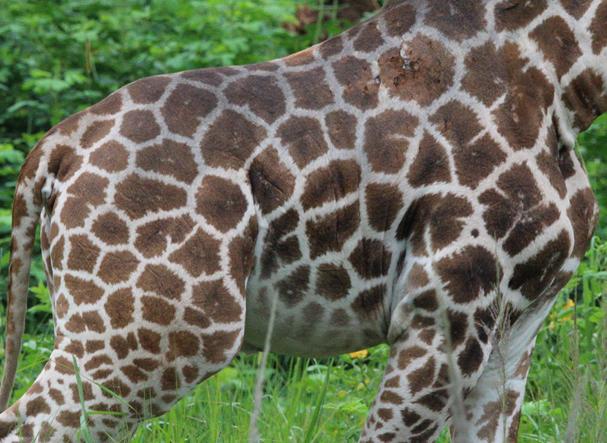Herbert Kasozi
My research seeks to investigate the direct effects of poaching and the indirect effects of oil mining on the endangered Rothschild’s giraffes (Giraffa camelopardalis rothschildi) in Murchison Falls National Park (MFNP), Uganda. To investigate the effects of both threats, I will conduct vehicle-based surveys and use photographic spatial-capture recapture techniques to: i) quantify the proportion of this population with snare injuries ii) document the number of giraffes killed by wire snares or spearing, iii) measure the impact of snare injuries on giraffe behavior (such as movement and feeding) and iv) estimate spatial variation in giraffe density in relation to oil activities.

Right side pattern for individual recognition of giraffes using the computer assisted photo recognition software – WILDID. © Herbert Kasozi.
Little is known about the ecology of the endangered Rothschild’s giraffes (Giraffa camelopardalis rothschildi) despite the fact that threats to their persistence across their range are increasing. Currently, the only known wild populations of Rothschild’s giraffes occur solely in Uganda and central/southwestern Kenya (Fennessy and Brenneman 2010). Murchison Falls National Park (MFNP) in Uganda supports over 70% of the estimated 1,671 remaining wild individuals of Rothschild’s giraffes (Muller et al. 2016; GCF 2017). Two factors threaten the survival of Rothschild’s giraffes in MFNP: i) illegal hunting (hereafter “poaching”; Travers 2017) and ii) oil mining (Prinsloo et al. 2011; Dohanuik et al. 2017; MacKenzie et al. 2017). Poaching in MFNP is rampant, driven by human livelihood needs, and is carried out by residents of impoverished communities that surround the park (Harrison et al. 2015; Travers 2017). In 2015, 40% of households in villages adjacent to MFNP were involved in poaching for commercial purposes (Travers 2017). Poachers in this landscape either trap wildlife by wire snares or directly kill wildlife by spearing.
My project seeks to examine individual and population level impacts of poaching and oil mining on Rothschild’s giraffes of the northern bank of MFNP. The specific objectives of my research are to; i) quantify the proportion of this population with snare injuries ii) document the number of giraffes killed by wire snares or spearing, iii) measure the impact of snare injuries on giraffe behavior (such as movement and feeding) and iv) estimate spatial variation in giraffe density in relation to oil activities.
These assessments are a crucial need given that the current wild population only numbers 1,671 individuals and poaching and oil mining may reverse the increasing population trends in MFNP (Muller et al. 2016). Additionally, quantifying the prevalence of poaching and oil mining will help to;
(i) map areas with highest numbers of giraffes with snare injury and therefore
(ii) optimize patrol, rescue, and snare removal operations by park management,
(iii) optimize planning for environmentally sound oil and gas activities.
Optimization of intervention planning and oil and gas activities will benefit other large mammals in the landscape such as lions (Panthera leo) and elephants (Loxodonta africana). Broadly, this work will lead to better understanding and appreciation of threats to giraffe population growth in MFNP.